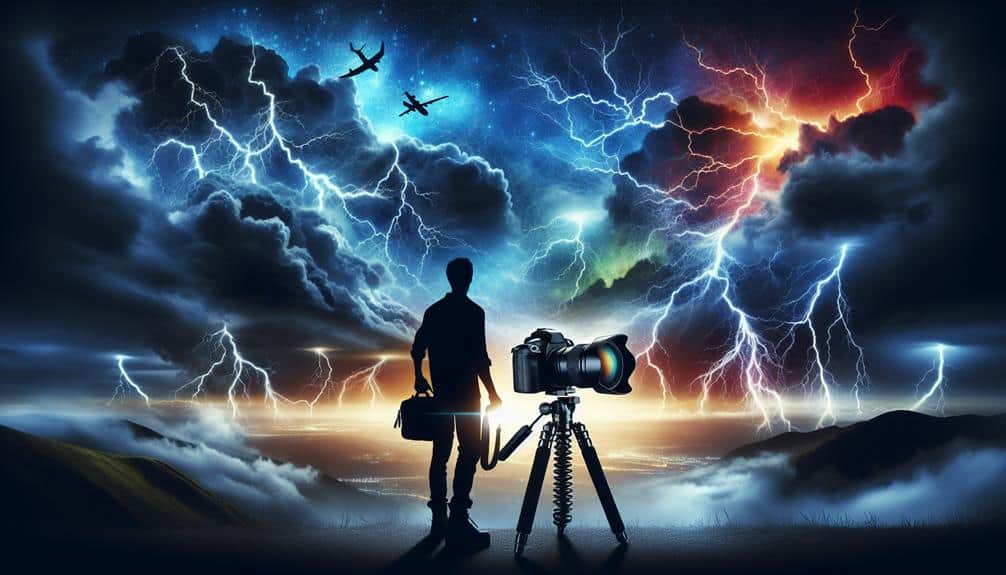To capture stunning lightning strikes, we need the right gear, a suitable location, and precise camera settings. Let's start with a sturdy tripod and a DSLR or mirrorless camera in manual mode, paired with a wide-angle lens. Our perfect location should offer unobstructed views and minimal light pollution, such as open fields or hilltops. For settings, we'll use a low ISO, a shutter speed between 5 and 30 seconds, and an aperture of f/8 to f/11, with manual focus set to infinity. By mastering these aspects, we'll elevate our lightning photography to the next level—let's explore further for advanced techniques.
Key Points
- Use a sturdy tripod and a DSLR or mirrorless camera in manual mode for stability and control.
- Set a low ISO (100-200) to minimize noise in long exposure shots.
- Choose a safe location with unobstructed views and minimal light pollution.
- Use a shutter speed between 5 to 30 seconds to effectively capture lightning strikes.
Choose the Right Gear
Selecting the right gear is important for successfully capturing the dramatic beauty of lightning strikes. First, let's talk about the fundamentals: a sturdy tripod, a DSLR or mirrorless camera with manual settings, and a wide-angle lens. These are our go-to tools for achieving those electrifying shots. The tripod guarantees stability, vital when we're dealing with long exposure times.
Our camera needs to allow manual control over ISO, aperture, and shutter speed. We usually set a low ISO to minimize noise and a small aperture to keep the depth of field. A wide-angle lens helps us capture the broader scene, enhancing the overall impact of the lightning strike's brilliance.
Gear maintenance is just as important. Before heading out, we always check our equipment for any signs of wear and tear. Clean lenses and sensor surfaces are a must to avoid unwanted smudges and dust spots in our photos.
Weather conditions play a significant role too. We monitor forecasts closely, aiming for stormy weather, but always prioritizing safety. Knowing when and where lightning is likely to strike helps us plan our gear setup efficiently.
Let's make sure our gear is ready and reliable, so we can focus on capturing those stunning, fleeting moments.
Find the Perfect Location
To capture the full magnificence of lightning strikes, we need to scout locations with unobstructed views of the horizon and minimal light pollution. Open fields, hilltops, and coastal areas are ideal, as they offer expansive views of the sky. By avoiding urban settings, we minimize artificial lighting conditions that can detract from the natural brilliance of lightning.
We should always prioritize safety measures. Lightning is unpredictable and dangerous, so finding a location that offers both a clear view and a safe retreat is necessary. Avoid tall structures, isolated trees, and bodies of water, as these can attract lightning. Instead, seek shelter in a vehicle; it provides a grounded, metal enclosure that ensures safety while still allowing us to capture the storm through open windows.
Timing our arrival is essential for best lighting conditions. Arriving before dusk allows us to set up and familiarize ourselves with the surroundings. This preparation helps us avoid obstacles and find the best angles for capturing lightning strikes.
With the right location, we can frame the shot artistically, ensuring that each bolt of lightning is perfectly highlighted against the dramatic backdrop of the stormy sky.
Master Camera Settings
Understanding and mastering the camera settings is necessary for capturing the fleeting beauty of lightning strikes with precision and artistic flair.
Let's start with exposure settings. We should set our cameras to manual mode, giving us full control over shutter speed, aperture, and ISO. A low ISO (100-200) minimizes noise, essential for clarity in long exposures.
For shutter speed, lightning photography often requires exposures ranging from 5 to 30 seconds. This ensures we capture the strike and its surrounding illumination. A sturdy tripod is a must to maintain stability during these long exposures.
Next, aperture adjustments play a pivotal role. An aperture of f/8 to f/11 strikes a balance between depth of field and the amount of light hitting the sensor. This range helps to keep both the foreground and background in focus while effectively managing the intense brightness of a lightning strike.
Focus techniques are equally crucial. Switching to manual focus and setting the lens to infinity ensures sharp images. It helps to pre-focus on a distant light source before the storm starts.
These settings, combined with a sense of timing and patience, will let's capture lightning in all its electrifying glory.
Frequently Asked Questions
What Safety Precautions Should I Take During a Lightning Storm?
Let's not play with fire. We need safety measures and proper gear. Always have an emergency plan, and know our shelter options. It's essential to stay safe and prepared during a lightning storm.
How Can I Predict When Lightning Will Strike?
We can predict when lightning will strike by using lightning storm tracking apps. Combining this with lightning photography techniques, we'll be ready to capture the perfect shot. Knowing weather patterns and storm behavior is essential.
Are There Specific Weather Conditions That Lead to Better Lightning Photos?
Remember that storm last July? We captured stunning lightning photos due to the perfect conditions: towering cumulonimbus clouds and high humidity. Using lighting photography techniques and ideal camera settings, we achieved incredible shots.
Can I Capture Lightning Strikes With My Smartphone?
Yes, we can capture lightning strikes with our smartphones despite their limitations. We've got to use manual settings, stabilize the device, and find the best angles to maximize our chances of snapping that perfect shot.
What Are Some Post-Processing Tips for Enhancing Lightning Photos?
When editing our lightning photography, we first enhance contrast to emphasize the bolts. For instance, using Lightroom, we adjust highlights and shadows. This technique dramatically improves our images, showcasing the raw power and beauty of lightning.


